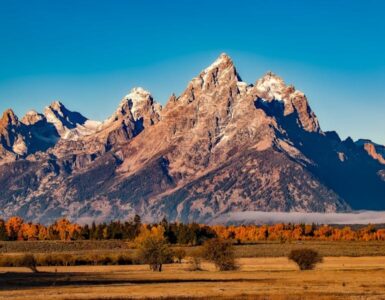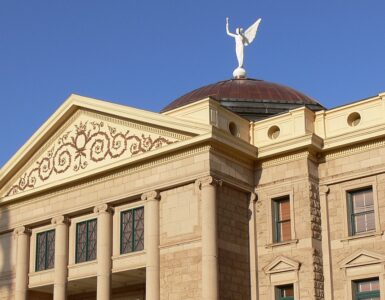Sen. Jon Kyl visited Chimney Springs in the Coconino National Forest just north of Flagstaff last week to listen to leaders from The Nature Conservancy (TNC) describe their innovative efforts in partnership with the United States Forest Service (USFS) to thin northern Arizona forests as part of a forest restoration initiative.
The goals of the Four Forest Restoration Initiative (4FRI) include fire prevention, water conservation and economic stimulation in the Flagstaff area.
“It’s not just to make the area look better, to have it be healthier for the flora and fauna and to have it more fire-resistant, but also to produce more water it’s capable of producing that’s not being consumed by the non-productive vegetation that’s here,” Kyl said. “One estimate is that you could generate another 10 to 16 percent more water. If instead of having relatively unproductive scrub trees here soaking up all of that water, that could run off in the watersheds for Lake Mary, for the city supply for Flagstaff or down further to serve the thirsty areas of the Salt River Valley; that’s a huge water savings.”
Kyl has been involved in forest restoration for decades, both in and out of the U.S. Senate, and he is an expert on the issue of water conservation in Arizona’s arid climate, said Rob Marshall, lead scientist and director of the forest and climate program at TNC.
“He’s worked hard in Congress to make appropriate changes that help us thin our forests more quickly,” Marshall said. “He’s been a strong advocate of forest restoration and a strong supporter of the Four Forest Restoration Initiative in particular.”
As part of 4FRI, TNC teamed up with USFS to implement restoration treatments across 2.4 million acres of ponderosa pine forest in the Coconino and Kaibab national forests. Chimney Springs is one of the stewardship areas chosen, Marshall said.
“We’re working on innovations to the Forest Service’s business practices so we can streamline and reduce costs, make their work more efficient,” Marshall said. “We’re trying to help the Forest Service, because industry is so important to getting the forest thinned. We’re trying to help the Forest Service work at the speed of industry.”
The efficiency effort begins with technology. Traditionally, USFS sends out foresters to mark trees with orange spray paint, indicating the trees that should be left untouched by harvesters using heavy tree-cutting machinery.
“Across the several million acres of the four forests, the (USFS) was spending a million dollars a year alone in paint,” Marshall said. “And the time required for people to go out there and figure out which trees should be left and then paint them. When you’re trying to scale up to a million-acre project, it’s just cost- and time-prohibitive.”
In response, TNC has devised a new way to mark trees: digital GPS mapping. Using satellite images of vast forested areas, foresters can digitally mark 50 to 80 acres per day instead of the more typical approximately eight acres a day they can mark with paint, and the time and paint savings result in more than a 75 percent reduction in cost, Marshall said. Harvesters carry tablets in their vehicles that show the marked areas. Using their own expertise to determine which trees are most accessible with the tree harvesting machine, they can quickly thin large sections of forest.
“The quicker we can get restoration done, the safer the community is,” Marshall said. “It’s as simple as that. It’s a race against time.”
Wildfires threaten public safety first and foremost, Marshall said. The most destructive fires in Arizona’s history have occurred within the last two decades: The Rodeo-Chediski Fire of 2002 burned almost half-a-million acres in Coconino and Navajo counties, and the Wallow Fire of 2011 burned an even larger area between eastern Arizona and western New Mexico.
Even relatively smaller fires can do extensive damage. The Schultz Fire of 2010 burned 15,000 acres of Coconino National Forest near Flagstaff, killing a 12-year-old girl and causing millions of dollars in damage to homes and natural habitats due to flooding and mudslides. Fire officials said the fire was caused by an unattended campfire.
Out-of-control wildfires also threaten precious water sources and jeopardize the region’s economy when USFS closes forests due to fire risk and tourism comes to a halt.
“Those forests drive the economy up there,” Marshall said. “So it’s about protecting the economy; it’s about protecting Phoenix’s water supply. We sometimes take those forests for granted, but they are kind of a foundation of both the rural economy as well as our more urban areas, because it’s the only in-state supply of renewable water that we have.”
Treating the forest through thinning and controlled fires has proven to work, preventing wildfires and creating more water runoff, but it has to be done soon, Kyl said. The communities around the forests have to work together along with USFS to move the restoration forward, and TNC’s contributions have helped make the process much more efficient, he said.
“There is a consensus that the forests have to be managed,” Kyl said. “You have to do mechanical thinning as well as prescribed burning. The combination of those things will treat the forest in such a way that nature can then take over later and do all of that for you on a cycle of five to seven years or whatever it might be.”
















Add comment